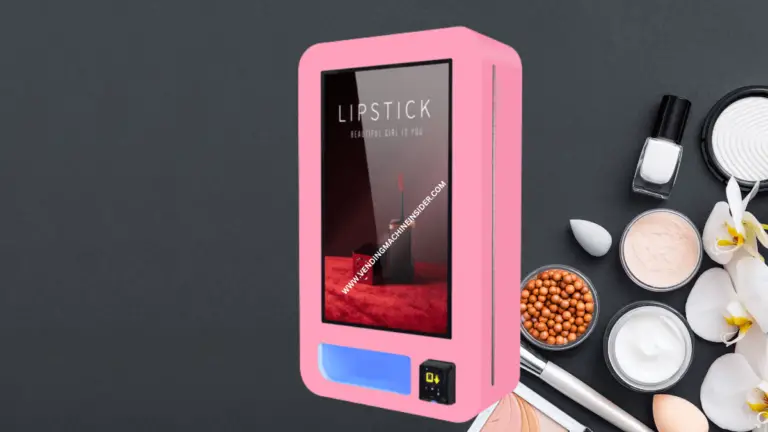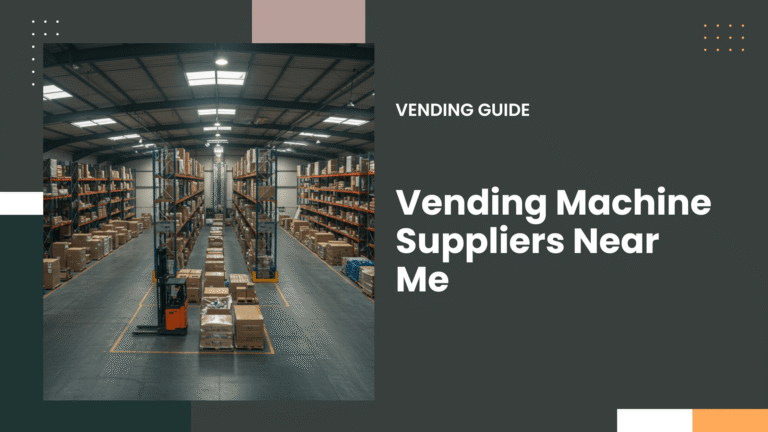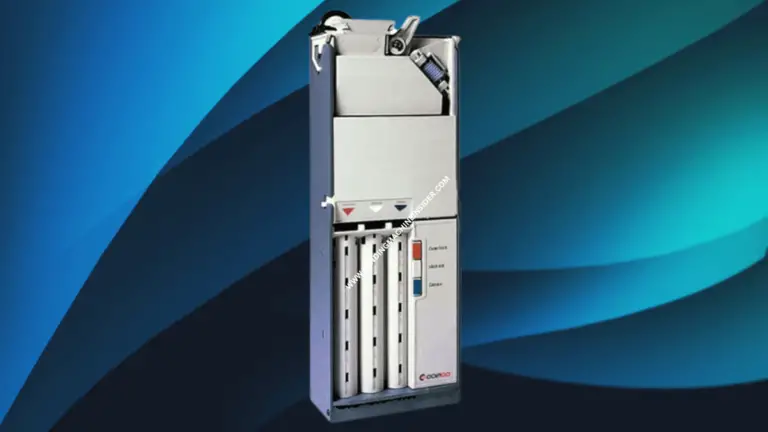How to Start a Vending Machine Business | Costs, Locations & Laws
Learn How to start a Vending Machine Business – Start by registering your company, securing the required permits, and purchasing or leasing machines. Next, choose profitable locations and stock popular products, maintaining equipment, tracking sales, and reinvesting profits to scale operations effectively.
How to Start a Vending Machine Business in the U.S.
The vending industry is one of America’s most quietly resilient markets. In 2025, it’s projected to generate nearly $40 billion in annual sales, a 30% jump since 2023. For entrepreneurs, that means opportunity: vending is a low-overhead, scalable business that can produce steady cash flow with the right setup.
But make no mistake — vending isn’t just about buying a machine and hoping people drop in quarters. Profitability hinges on three things: choosing the right machine for your market, placing it in the right location, and staying compliant with state regulations. This guide walks you through every step: from machine types and financing options to profit margins, ROI timelines, and a detailed breakdown of state-by-state rules.
Step-by-Step Guide
- Decide your goal: passive cash flow with a few machines, or scale to a full route/micro-market business.
- Research locations: walk candidate sites, count traffic, and ask property owners about placement terms.
- Choose machine type: snack, beverage, combo, coffee, healthy, micro-market, or specialty.
- Budget & finance: calculate machine, inventory, permits, transport, and a 3-month cushion. See Financing section below for detailed steps.
- Register & comply: form an LLC (or similar), obtain EIN, sales tax permit, and local health permits as required.
- Acquire & equip: buy new or used; add cashless readers and telemetry to increase sales and reduce routings.
- Install, stock & display contact: set prices, post service contact and machine ID as required by some states.
- Track, optimize & scale: maintain records, rotate SKUs, monitor margins, and expand routes when profitable.
Vending Machine Profitability Calculator
Smart Recommender — pick state, budget & goals
Types of Vending Machines
New vs. Used Machines
New Machines: reliability, warranties, modern features (cashless payments, telemetry, energy efficiency). Typical costs: $3,000–$10,000 depending on type. Better for operators who want lower maintenance early on.
Used Machines: 30–70% cheaper; e.g., used snack machine $1,000–$2,000. Tradeoffs: older tech, possible parts/repairs, no warranty. Upgrading with a card reader can extend value — smart for first-time operators testing markets.
Choosing the Right Machine for Your Market
Match the machine to your location demographics:
- Workplaces/Offices: snacks & drinks; coffee machines for larger firms (50+ employees).
- Schools & Universities: healthier options & cashless payments are popular; ensure K–12 compliance.
- Hospitals & Care Centers: 24/7 demand; variety (snacks, drinks, coffee) works well.
- Gyms: sports drinks, protein bars, healthy snacks.
- Hotels: lobby machines for late-night guests.
- Retail & Malls: placed near entrances and food courts for impulse buys.
- Transit Hubs: high volume, strong sales ($300–$1,500/month possible per machine).
Identifying Profitable Locations
Look for high foot traffic and captive audiences:
- Factories & warehouses (shift work)
- Office buildings (break rooms)
- Apartment complexes (lobbies, laundry rooms)
- Hospitals & nursing homes (24/7)
- Car dealerships & service centers (long waits)
- Schools & universities (many daily users)
- Gyms & fitness clubs (healthy vending)
- Transit hubs (airports, stations)
Startup Costs & Financing (summary)
Machine costs: new $2,000–$10,000+ depending on type. Used: $1,000–$3,500 (snack vs soda differences).
| New machines | $2,000–$10,000+ |
| Used machines | $1,000–$3,500 |
| Initial inventory | $500–$1,500 |
| Monthly restock | $200–$500 per machine |
| Card readers & telemetry | $100–$400 |
| Licensing/insurance | $50–$500 |
Financing Options — step-by-step & checklist
High-level financing choices:
- Self-funding: No interest, fastest to deploy, preserves credit.
- SBA / Bank loans: Lower rates but longer approval and documentation (best for scaling).
- Equipment leasing: Preserve cash flow; typical payment example: $5,000 machine ≈ $150/month depending on terms.
- Business line of credit: Flexible for inventory and repairs.
- Revenue-share placements: Low upfront cost; split revenue with property owner, but margins reduce.
- Merchant cash advances: Fast but expensive — avoid unless necessary.
Step-by-step — prepare to finance
- Calculate exact capital need: machine cost + inventory + permits + 3 months working capital. Example: $3,000 (machine) + $800 (inventory) + $200 (permits) + $1,200 (cushion) = $5,200.
- Choose financing mix: start with self/loans/lease comparison — compare APR, fees, term length, and early-payoff penalties.
- Documentation checklist: business formation docs, EIN, recent bank statements (3–6 months), tax returns, simple revenue forecast, machine quotes/receipts.
- Shop local lenders & lessors: credit unions and equipment lessors often give good terms for small equipment.
- Negotiate and finalize: prefer fixed monthly payments with clear amortization; avoid hidden fees.
Practical examples
Loan example: $10,000 loan at 8% APR for 36 months ≈ monthly payment $313. Use an amortization calculator for exact totals.
Lease example: $5,000 machine leasing at $150/month — preserves cash but increases long-term cost vs buying outright.
Profitability & ROI (how to calculate)
Margins in vending are healthy when managed: typical net profit averages 20–25% of sales; premium items (coffee, health foods) can reach 30–45%.
Quick formulas (use calculator above)
- Monthly revenue = number of machines × avg monthly sales per machine.
- Product cost = monthly revenue × product cost %.
- Total monthly expenses = product cost + restock + commission + card readers + electricity + insurance + misc + financing + sales tax.
- Net monthly profit = monthly revenue − total monthly expenses.
- Break-even months (ROI) = initial investment ÷ net monthly profit (if positive).
Example (digit-by-digit): Machine cost $3,000, net monthly profit $300 → 3000 ÷ 300 = 10 months to break even (simple payback).
Upside strategies: add cashless payments (+15–20% sales), rotate seasonal items, use telemetry to reduce route frequency and theft loss.
Inventory Management & Maintenance
Systems beat luck — build simple repeatable processes:
- Tracking: start with a spreadsheet or use vending software for telemetry and real-time reporting.
- Restocking: high-traffic machines weekly; lower traffic biweekly/monthly. Budget $200–$500/month per busy machine.
- Maintenance: keep a repair budget $50–$200 per call; retain a basic toolkit and spare parts for common failures.
- Electricity: typically $10–$50/month per machine depending on refrigeration and usage.
- Security & cash handling: anchor machines, empty cash boxes regularly and use cashless when possible.
- Customer service: post clear contact info and respond quickly to refunds/issues to maintain good property-owner relationships.
Legal Compliance & Paperwork
Basics (apply to most states):
- Business registration: LLC or sole proprietorship; register with Secretary of State; get EIN.
- Sales tax permit: collect & remit sales tax in most states (exceptions include OR, DE, MT, NH — verify local rules).
- Vending operator license / machine registration: many states require per-machine permits or decals (fees vary).
- Health permits: required for perishable/fresh food or coffee; check county/city health departments.
- Special permits: tobacco, alcohol, gaming or amusement devices often need extra licensing — some states ban tobacco vending entirely in certain contexts.
- Insurance: General liability; property owner may require proof of coverage.
Quick checklist to bring to property owners: Business registration docs (LLC), EIN, proof of insurance, proposed placement agreement (term, revenue share), and machine identification / service contact.
State-by-State Summary (high-level)
Concise highlights for each state. Always verify with state and local offices before launching.
Open full 50-state highlights
Business & contact (example)
Suite 210
Austin, TX 78701






